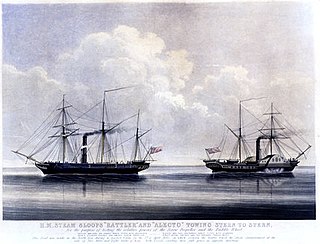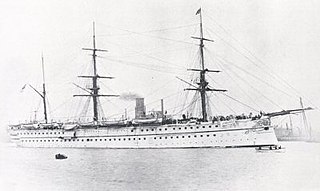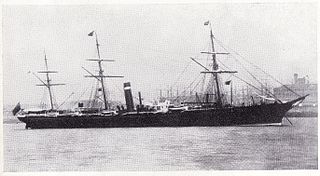
Sir Henry Bessemer was an English inventor, whose steel-making process would become the most important technique for making steel in the nineteenth century for almost one hundred years. He also played a significant role in establishing the town of Sheffield, nicknamed ‘Steel City’, as a major industrial centre.

The PS Medway Queen is a paddle driven steamship, the only mobile estuary paddle steamer left in the United Kingdom. She was one of the "little ships of Dunkirk", making a record seven trips and rescuing 7,000 men in the evacuation of Dunkirk.

HMS Gorgon was a wooden steam paddle sloop of 6 guns, launched in 1837. In 1840 she took part in the bombardment of Acre, and in 1843 was part of the Royal Navy squadron stationed in the River Plate during the Uruguayan Civil War. She was converted to a troopship and in 1858 assisted Agamemnon in the laying of the first transatlantic telegraph cable. She was sold for breaking in 1864.

SS Britannic was an ocean liner of the White Star Line. She was the first of three ships of the White Star Line to sail with the Britannic name.
HMS Repulse was the last wooden battleship constructed for the Royal Navy.
Earle's Shipbuilding was an engineering company that was based in Hull, East Riding of Yorkshire, England from 1845 to 1932.

HMS Rattler was a 9-gun steam screw sloop of the Royal Navy, and one of the first British warships to be completed with screw propulsion. She was originally ordered as a paddle wheel 4-gun steam vessel from Sheerness Dockyard on 12 March 1841. She was reordered on 24 February 1842 as a propeller type 9-gun sloop from HM Royal Dockyard, Sheerness, as a new vessel. William Symonds had redesigned the ship as a screw propeller driven vessel.

The Lucinda was a Queensland Government owned, 301-ton paddle steamer built by William Denny and Brothers, Dumbarton, Scotland in 1884.

USS Clyde was a paddle steamer captured by the Union Navy during the American Civil War, and commissioned to patrol Florida waters. She had been built in 1861 in Glasgow, Scotland as the Clyde passenger steamer Neptune, but sold in 1863 to become a blockade runner, making two successful round trips to Mobile, Alabama before capture. After the war she was sold to mercantile interests as Indian River, but lost shortly afterwards.

HMS Himalaya was built for the Peninsular and Oriental Steam Navigation Company as SS Himalaya, a 3,438 gross register ton iron steam screw passenger ship. She was purchased by the Royal Navy in 1854 for use as a troopship until 1894 and was then moored in the Hamoaze, Devonport to serve as a Navy coal hulk until 1920, when sold off. She was sunk during a German air attack on Portland Harbour in 1940.

HMS Euphrates was an iron-hulled troopship of the Euphrates class. She was designed for the transport of British troops to India, and launched in the River Mersey on 24 November 1866 by Laird Brothers of Birkenhead. She was the fourth and last Royal Navy ship to bear the name.

City of Paris was a British passenger liner operated by the Inman Line that established that a ship driven by a screw could match the speed of the paddlers on the Atlantic crossing. Built by Tod and Macgregor, she served the Inman Line until 1884 when she was converted to a cargo ship.

SS President was a British passenger liner that was the largest ship in the world when she was commissioned in 1840, and the first steamship to founder on the transatlantic run when she was lost at sea with all 136 onboard in March 1841. She was the largest passenger ship in the world from 1840 to 1841. The ship's owner, the British and American Steam Navigation Company, collapsed as a result of the disappearance.
Arpha was a 602 GRT passenger ferry built in 1900 as Canterbury for the South Eastern and Chatham Railway. She passed to the Southern Railway on 1 January 1923. She was sold to W E Guinness in 1926 and renamed Arpha. In 1938 she was sold to Sark Motorships Ltd, only to be requisitioned by the Royal Navy in 1939. Postwar, she was sold to Compania Shell de Venezuela and renamed Coriano. After a further change of ownership she was scrapped in 1955.

HMS Salamander was one of the initial steam powered vessels built for the Royal Navy. On 10 January 1831 the First Sea Lord gave orders that four paddle vessels be built to competitive designs. The vessels were to be powered by Maudslay, Son & Field steam engines, carry a schooner rig and mount one or two 10-inch shell guns. Initially classed simply as a steam vessel (SV), she was re-classed as a second-class steam sloop when that categorization was introduced on 31 May 1844. Designed by Joseph Seaton, the Master Shipwright of Sheerness, she was initially slated to be built in Portsmouth, and was changed to Sheerness Dockyard. She was launched and completed in 1832, took part in the Second Anglo-Burmese War and was broken up in 1883.
Dorothea Weber was a 190 GRT three-masted Schooner that was built in 1922 as the barge Lucy by J Oelkers, Hamburg. She was later renamed Midgard I, Midgard IV and then Elisabeth before a sale in 1935 saw her fitted with a diesel engine and renamed Dorothea Weber. She was seized by the Allies in May 1945 at Guernsey, passed to the Ministry of War Transport (MoWT) and renamed Empire Cononley.

Castalia was a 1,533 GRT twin-hulled paddle steamer that was built in 1874 by the Thames Ironworks and Shipbuilding Company, Leamouth, London for the English Channel Steamship Company. She was acquired by the London, Chatham and Dover Railway (LCDR) in 1878 but had already been laid up by then and was not operated by the LCDR. In 1883, she was sold to the Metropolitan Asylums Board and converted to a hospital ship. She served until 1904 and was scrapped in 1905.

SS Empress Queen was a steel-hulled paddle steamer, the last of her type ordered by the Isle of Man Steam Packet Company. The Admiralty chartered her in 1915 as a troop ship a role in which she saw service until she ran aground off Bembridge, Isle of Wight, England in 1916 and was subsequently abandoned.

SS (RMS) Mona (III), the third ship of the Company to bear the name, was a steel paddle-steamer which was originally owned and operated by the London, Chatham and Dover Railway Company, who then sold her to the Liverpool and Douglas Steamship Company, from whose liquidators she was acquired by the Isle of Man Steam Packet Company in 1903.

The PS Gem is a retired side-wheel paddle steamer that was first launched in 1876 on the Murray River at Moama, New South Wales. She operated as a cargo and passenger steamer, regularly cruising between Morgan and Mildura. The Gem operated as a tourist passenger vessel during the 1930s and 1940s, and was retired in the early 1950s. In 1962 the Gem was sold to the then Swan Hill Folk Museum, where it would become a static display and historic monument.


















